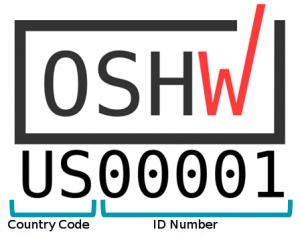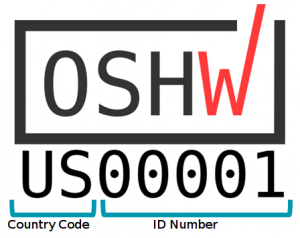This post originally appeared on the OSHWA blog.

Today the Open Source Hardware Association is excited to announce the OSHWA Open Source Hardware Certification program. The program allows hardware that complies with the community definition of open source hardware to display a certified open source hardware logo. It will also make it easier for users of open source hardware to track down documentation and more information. You can check out the program here, and keep on reading for some information about how it will work.

These companies and organizations have agreed to certify at least one piece of hardware by the end of this year.
Background and Purpose
Almost a year and a half ago, OSHWA announced its intention to explore the creation of an Open Source Hardware certification. At that point, the open source hardware community had created a community definition of open source hardware and the open source hardware open gear logo. Both of these were significant contributions to the growth in awareness around open source hardware.
By design, no one owns the term “open source hardware” or the open gear logo. This allowed both the term and the logo to be widely adopted by the community. However, it also created a challenge. In many cases, creators would label their hardware as being open source and use the open gear logo without complying with the community definition. This created confusion in the community where users were unsure what it really meant when something was labeled “open source hardware”.
The certification is designed to complement the existing open gear logo by bringing clarity to how the creator is using the term “open source hardware”. Unlike the open gear logo, the certification logo is controlled by OSHWA. In order to use the certification logo, a hardware creator must make a legally binding promise that their hardware complies with the community definition of open source hardware. That means that when users see the certificated open source hardware logo they know the hardware complies with the community definition of open source hardware.
In the summer of 2015, OSHWA asked the community a number of questions about how a certification might work and what kind of value it might bring. By the 2015 Open Hardware Summit, those discussions had coalesced around version 1 of the Open Source Hardware Certification Specification. In the year since, OSHWA has worked with the Juelsgaard Intellectual Property and Innovation Clinic at Stanford University Law School to turn that specification into a fully functional registration system.
The System
Starting today, you can register your hardware for free by certifying that it complies with the community definition of open source hardware. The registration site –certificate.oshwa.org – has an overview of the process, the text of the license agreement for use of the certification logo, guidelines for how the logo can be used, a history of the certification process, an FAQ related to the certification, a form that allows you to register your hardware, and a directory of registered hardware that includes links to relevant documentation and information.
Upon registration, you will receive the right to use the certification logo and a unique identifier for the registered version of your hardware.

That unique ID has two components. The first two characters represent a country code. Open source hardware is a worldwide community, and the country code is an opportunity to recognize and celebrate that fact. The remaining characters are numbers assigned sequentially based on when the hardware was registered.
The Importance of Your Contribution
One of the critical elements of the certification process is the idea of the creator contribution. Hardware often involves many third party components outside of the control of the designer. Therefore, it is unreasonable to require every component of a piece of hardware to be fully open before becoming certified.
The creator contribution rule is an attempt to address this issue. In order to certify a piece of hardware, the creator must fully open any elements of the hardware that is within their control. If they have the legal ability to license it, it must be licensed openly. If they created documentation, that documentation must be freely distributed.
If components were created by third parties, the creator does not have the ability to license them or distribute the documentation. In those cases, the creator merely has to disclose the parts in the bill of materials and certify that they are available without an NDA. This system allow creators to distribute legitimately open source hardware without creating a (currently) unrealistic burden to find fully open components.
Assistance
OSHWA has designed this process to be as user friendly and straightforward as possible. However, it does require users of the certification to make a legally binding promise that they will only use the certification logo on hardware that complies with the community definition. We recognize that this sort of legal promise can raise concerns or cause uncertainty for some community members. Therefore, we encourage users to write in to certification@oshwa.org with questions.
While OSHWA will work hard to answer as many questions as possible, some questions may require legal advice. That is why we have partnered with the Cardozo Law School Tech Startup Clinic. The clinic has agreed to receive referrals from OSHWA for free and low-cost legal advice regarding the certification process. We hope to add additional clinics and resources to this program in the future. (If you are a lawyer who would like to be involved with the referral program, please contact us at certification@oshwa.org).
About Those Unique IDs
Ever since we started discussing unique IDs that were sequential, we’ve gotten variations of a single question: “how can I get a low number?” In order to give as many community members as possible the opportunity to obtain a coveted low unique ID number, we have decided not to start issuing numbers until the end of October. All hardware registered before the end of October will be combined into a single pool, from which we will issue IDs starting November 1. That means that all pieces of hardware registered before the end of the month have an equal opportunity at low registration numbers. Starting November 1, we will start issuing IDs as hardware is registered.
Version 1
This is the first version of the OSHWA Open Source Hardware Certification program. It was designed with a great deal of community input and is intended to complement existing pillars of the community. We hope that you take a look, try it out, and find it useful. At the same time, we know that as the certification program grows we will find things that can be improved and applications that we failed to anticipate. That’s why we welcome your thoughts and ideas in the comments of this post, in the forums, in the certification@oshwa.org inbox, and online @OSHWassociation.
In order to provide that feedback, you first need to check out the certification. So stop reading this blog post, click on over to certificate.oshwa.org, and register something!
Don’t have anything documented enough to register? Bring a project to one of theDocumentation Days around the world (or host your own) as part of Open Hardware Month so you can make it easier for people to build on your stuff.